HTML5, CSS3, and JavaScript
13 likes4,010 views
Lecture slides and videos from my talk at the 2011 Montgomery College Student Web and Gaming Conference.
1 of 49
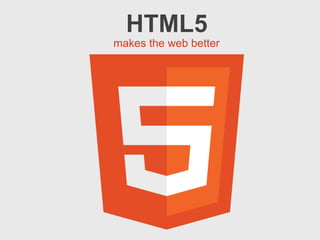

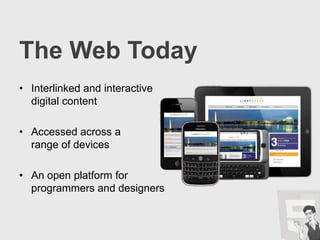
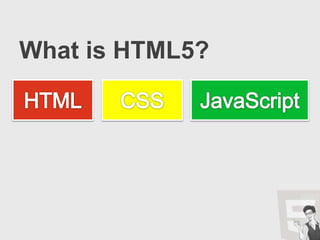


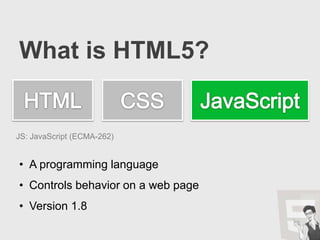

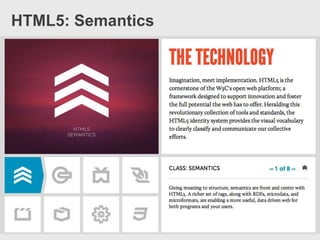





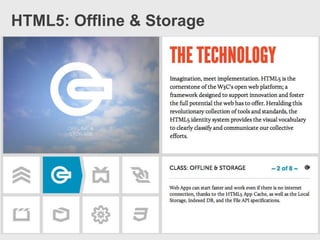


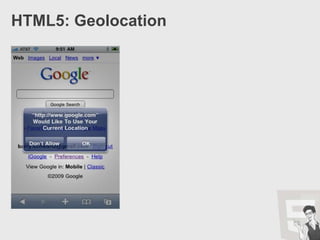
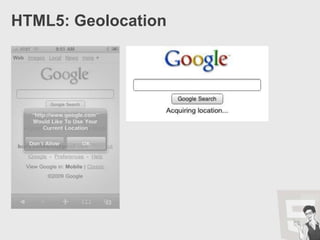

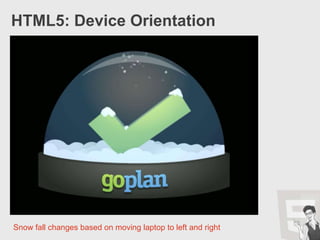


















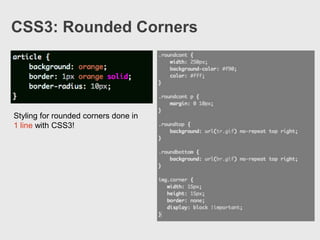









Ad
Recommended
Presentation about html5 css3



Presentation about html5 css3Gopi A This presentation about HTML5 and CSS3 presents with example and described valid points with simple example code and live preview.
70-480 - Programming in HTML5 with JavaScript and CSS3



70-480 - Programming in HTML5 with JavaScript and CSS3Roxycodone Pills 70-480 and find official preparation materials to complete the Programming in HTML5 with JavaScript and CSS3 Specialist certification.
http://www.pass4sureexam.com/70-480.html
Introduction to HTML5 and CSS3



Introduction to HTML5 and CSS3Chandra S Oemarjadi Interested in HTML5 and CSS3? You can start here :D
Glimpse of HMTL5 and CSS3 features, and some references for further learning.
HTML5 & CSS3 



HTML5 & CSS3 Ian Lintner HTML was first defined by Tim Berners-Lee in 1991 and has evolved through several versions. HTML5 and CSS3 are the next generation standards that will enhance the richness and interactivity of web content. HTML5 introduces new semantic tags and APIs for multimedia, geolocation, and offline storage. CSS3 includes features for rounded corners, drop shadows, columns, animations, and media queries for responsive design. While legacy browsers present challenges, HTML5 and CSS3 will improve the functionality of the mobile web and make the interface of the web comparable to native applications.
Fundamental CSS3



Fundamental CSS3Achmad Solichin The document discusses various topics in CSS3 including selectors, properties, media queries, and visual effects. It provides examples and explanations of CSS3 concepts like gradients, rounded corners, box shadow, text shadow, opacity, and more. Browser support and cross-browser compatibility of CSS3 features are also covered.
CSS3 Introduction



CSS3 IntroductionJaeni Sahuri CSS3 is the latest standard for cascading style sheets (CSS). CSS3 introduces several new modules that expand the capabilities of CSS, including selectors, box model, backgrounds/borders, image values, text effects, transformations, animations, multiple column layout, and user interface. The document provides examples of CSS3 properties and modules, demonstrating borders, selectors, text effects, menus, and creating multiple columns. It concludes by thanking some websites for information on CSS3.
Introduction to HTML5 and CSS3 (revised)



Introduction to HTML5 and CSS3 (revised)Joseph Lewis Joseph R. Lewis of Sandia National Laboratories gave a presentation on HTML5 and CSS3 at Oak Ridge National Laboratory. The presentation provided an overview of the history that led to the development of HTML5, described new HTML5 semantic elements and attributes, and covered features of HTML5 like Canvas, SVG, and MathML. It also covered new CSS3 properties and exercises for attendees to experiment with the new technologies.
HTML CSS and Web Development



HTML CSS and Web DevelopmentRahul Mishra The document provides information on various topics related to web development including HTML, CSS, JavaScript, PHP and other technologies. It discusses common HTML tags like <head>, <body>, <p>, <img>, <a> and how to structure an HTML document. It also covers CSS concepts like selectors, properties and values. Finally, it summarizes different form elements in HTML like <input>, <textarea>, <select>, <button> and how to collect user information and submit it using forms.
Web Development



Web DevelopmentHarshdeep Singh Web development involves both front-end development and back-end development. Front-end development includes using languages like HTML, CSS, and Bootstrap to define the layout and visual design of websites. Back-end development involves using languages like SQL and PHP to manage the database and functional aspects of websites that users do not see. Key front-end technologies are HTML for content, CSS for styling, and Bootstrap for responsive design. Key back-end technologies are SQL for databases and PHP for server-side scripting.
HTML CSS & Javascript



HTML CSS & JavascriptDavid Lindkvist - HTML, CSS, and JavaScript are becoming the new standard for building applications and interactive experiences on the web.
- Best practices include using semantic HTML, clean CSS with a focus on maintainability, and JavaScript performance optimizations.
- Key techniques discussed are image sprites, progressive enhancement, and jQuery selector chaining to reduce DOM lookups.
Training HTML5 CSS3 Ilkom IPB



Training HTML5 CSS3 Ilkom IPBWahyu Putra This document provides information about a 2-day workshop on building websites with HTML5 and CSS3 to be held on May 16-17, 2015. The agenda covers fundamental concepts of HTML5 and CSS3 like forms, media queries, and frameworks. The speaker is Wahyu Putra, a chief technology officer and UI/UX designer.
Basics of css and xhtml



Basics of css and xhtmlsagaroceanic11 This document discusses HTML5 and CSS3 and how they can be used to enhance the user experience on websites. It provides an overview of key features of HTML5, such as offline storage, video and audio embedding, graphics capabilities, and geolocation. It also outlines visual enhancement capabilities of CSS3, such as shadows, gradients, and animations. The document advocates testing new technologies and observing how other applications use them, while also encouraging responsible development. It concludes by noting that HTML5 and CSS3 will continue pushing the web towards cloud computing.
Building a Better Web with HTML5 and CSS3



Building a Better Web with HTML5 and CSS3Karambir Singh Nain HTML5 and CSS3 provide improvements to building the web. HTML5 introduces more semantic tags that improve accessibility and cleaner code. It also provides native support for video, audio, local storage and better interactions. CSS3 enhances presentation. HTML5 is supported across modern browsers and on mobile, allowing responsive design. New features like canvas and WebGL enable graphic effects. Geolocation allows accessing a user's location with permission. HTML5 aims to make the web platform more powerful and flexible.
A practical guide to building websites with HTML5 & CSS3



A practical guide to building websites with HTML5 & CSS3Darren Wood The document provides an overview of HTML5 and CSS3 features for a presentation. It begins by introducing the presenter and their experience with WordPress, HTML, and CSS. It then covers new elements in HTML5 like video, audio, forms, and semantics. For CSS3, it discusses selectors, properties and fonts. The presenter notes they will focus on useful features they commonly use and not cover everything due to time constraints. They ask for questions and indicate they are still learning.
Front end development best practices



Front end development best practicesKarolina Coates Slides from 'Back to Basics' quarterly theme presentation @Version 1 covering: general front-end best practice guidelines,HTML markup, CSS, Java Script, Accessibility, Performance, Cross-browser compatibility, Code Reviews and Tools & resources
Intro to CSS3



Intro to CSS3Denise Jacobs CSS3 isn't the future, it's the present. Learn the gamut of CSS3 properties from colors, web fonts, and visual effects, to transitions, animations and media queries. Find the inspiration and resources to go forth and implement the new properties with confidence.
Intro to HTML, CSS & JS - Internship Presentation Week-3



Intro to HTML, CSS & JS - Internship Presentation Week-3Devang Garach The document provides an agenda and details for a weekly presentation during a training program on information technology. The presentation covers HTML, CSS, and JavaScript. It defines HTML and the differences between HTML4 and HTML5. It describes the HTML5 structure and semantic elements. It also defines CSS and why it is used, CSS selectors and syntax, the box model, CSS units, and different types of JavaScript functions.
Modern Web Development



Modern Web DevelopmentRobert Nyman Talks about the best practices in web development regarding semantics, accessibility, SEO and performance.
web designing course bangalore



web designing course bangaloreInfocampus Logics Pvt.Ltd. Learn web designing course Bangalore, infocampus is providing best web designing courses, classes, and free demo classes 4 days with 100% job placement assistance.
Contact: 9738001024...for more details
Enquire on our website-www.infocampus.co.in
Web development



Web developmentGarvitBaleshwar The document discusses web development and provides an overview of key topics including HTML, CSS, JavaScript, and sample projects. It introduces HTML tags and elements, CSS syntax and types, JavaScript syntax, and provides code examples of simple HTML, CSS, and JavaScript documents. It also outlines three projects: a portfolio site using HTML and CSS, a static website using HTML and CSS, and a dynamic website using HTML, CSS, and JavaScript.
Web Development basics with WordPress



Web Development basics with WordPressRashna Maharjan This document provides an overview of basics in web development including HTML, CSS, JavaScript, and WordPress. It discusses the structure and components of HTML, different HTML elements and tags, CSS syntax and selectors, uses of JavaScript, and an introduction to WordPress including why it is commonly used and the WordPress development process. The document aims to provide foundational knowledge on key web development technologies through explanations, examples, and a quiz.
HTML5 CSS3 Basics 



HTML5 CSS3 Basics Srinivas Tamada HTML5 introduced several new features including semantic HTML tags, media tags for audio and video, improved form validation, geolocation, local storage and web sockets capabilities. It also reduced unnecessary code in headers and provided more input types. CSS3 introduced responsive design, rounded corners using border-radius, text effects, web fonts, and transitions for animated effects.
The road to professional web development



The road to professional web developmentChristian Heilmann My presentation in Taiwan about the history of web development and what practices make sense and got followed in the YUI.
Front End Best Practices



Front End Best PracticesHolger Bartel Front End Best Practices: A Selection of Best Practices, Tips, Tricks & Good Advice For Today’s Front End Development. Practices mentioned in this presentation range from basic principles to more advanced tools and techniques. By Holger Bartel for WomenWhoCodeHK 23/07/2014
Html5



Html5Nitish Sharma HTML5 is the latest version of HTML that aims to improve the language with new multimedia and web application features while keeping it easily readable by humans and consistently understood by computers. It is still a work in progress but supported by major browsers. Key features include new elements for media playback, local storage APIs, and form controls. HTML5 also introduces new APIs for graphics, offline apps, and other features. It allows for cross-platform programming and powers mobile apps on platforms like Tizen, Firefox OS, and Windows 8.
html5_css3



html5_css3Sindh Madresatul Islam University This document provides an overview of HTML5 and CSS3 topics. It begins with an agenda for HTML5 that covers basics like tags, attributes and elements. It then discusses HTML5 semantic elements and features like video, audio, and forms. For CSS3, it outlines modules including borders, backgrounds, gradients, text effects, web fonts, transforms, transitions, animations, columns and user interface. The document aims to introduce key concepts and properties for front-end development.
Dive into HTML5: SVG and Canvas



Dive into HTML5: SVG and CanvasDoris Chen Developers keep hearing a lot about HTML5, but many don’t know what it actually means or is truly capable of. In this deep dive you will learn how to use HTML5 to solve existing challenges on the web and how to design and develop stunning HTML5 application. You will also preview HTML5 application runs cross platforms, in the desktop browsers as well as on the Phones. What will be covered in the session:
• Introduction to CSS3, Canvas, SVG, Video, and Audio
• What is the real potential of HTML5 using CSS3, Canvas, SVG, Video, Audio, and JavaScript?
• Canvas and SVG comparison, and when to use what
• Best Practices of writing good HTML5 application
• Come and see a collection of the best HTML5 application on Games, Videos, Movies, Comics, Travel, Music and Art
• Expect a lot of demos and code
Presentation and demo will be available at http://blogs.msdn.com/b/dorischen/
An Introduction To HTML5



An Introduction To HTML5Robert Nyman This document provides an introduction to HTML5:
- It discusses backwards compatibility, progressive enhancement, and the <!DOCTYPE html> declaration in HTML5.
- It describes the syntax options of HTML or XHTML and provides examples of new HTML5 elements like <video>, <canvas>, and various new <input> types.
- It includes a full sample HTML5 page with new elements, semantics, and WAI-ARIA roles for accessibility.
Introduction to HTML5 & CSS3



Introduction to HTML5 & CSS3Pradeep Varadaraja Banavara This document discusses new features in HTML5 and CSS3. It provides examples of new HTML5 elements like <header>, <nav>, <article>, and new forms elements. It also covers new CSS3 features like gradients, rounded corners, shadows. Additionally, it mentions new JavaScript APIs in HTML5 for things like geolocation, drag and drop, offline web apps, storage and more. Finally, it encourages developers to use new web standards and provides resources for learning HTML5.
Html5/CSS3



Html5/CSS3Simratpreet Singh This document discusses HTML5, CSS3, and web fonts. It provides an overview of new features in the HTML5 and CSS3 specifications like new elements, attributes, media embedding, and animation. It also discusses different approaches for using these new technologies in older browsers, such as Modernizr, polyfills, and IE filters. Web fonts allow using non-system fonts and the document discusses hosted and local solutions as well as how to implement @font-face.
More Related Content
What's hot (20)
Web Development



Web DevelopmentHarshdeep Singh Web development involves both front-end development and back-end development. Front-end development includes using languages like HTML, CSS, and Bootstrap to define the layout and visual design of websites. Back-end development involves using languages like SQL and PHP to manage the database and functional aspects of websites that users do not see. Key front-end technologies are HTML for content, CSS for styling, and Bootstrap for responsive design. Key back-end technologies are SQL for databases and PHP for server-side scripting.
HTML CSS & Javascript



HTML CSS & JavascriptDavid Lindkvist - HTML, CSS, and JavaScript are becoming the new standard for building applications and interactive experiences on the web.
- Best practices include using semantic HTML, clean CSS with a focus on maintainability, and JavaScript performance optimizations.
- Key techniques discussed are image sprites, progressive enhancement, and jQuery selector chaining to reduce DOM lookups.
Training HTML5 CSS3 Ilkom IPB



Training HTML5 CSS3 Ilkom IPBWahyu Putra This document provides information about a 2-day workshop on building websites with HTML5 and CSS3 to be held on May 16-17, 2015. The agenda covers fundamental concepts of HTML5 and CSS3 like forms, media queries, and frameworks. The speaker is Wahyu Putra, a chief technology officer and UI/UX designer.
Basics of css and xhtml



Basics of css and xhtmlsagaroceanic11 This document discusses HTML5 and CSS3 and how they can be used to enhance the user experience on websites. It provides an overview of key features of HTML5, such as offline storage, video and audio embedding, graphics capabilities, and geolocation. It also outlines visual enhancement capabilities of CSS3, such as shadows, gradients, and animations. The document advocates testing new technologies and observing how other applications use them, while also encouraging responsible development. It concludes by noting that HTML5 and CSS3 will continue pushing the web towards cloud computing.
Building a Better Web with HTML5 and CSS3



Building a Better Web with HTML5 and CSS3Karambir Singh Nain HTML5 and CSS3 provide improvements to building the web. HTML5 introduces more semantic tags that improve accessibility and cleaner code. It also provides native support for video, audio, local storage and better interactions. CSS3 enhances presentation. HTML5 is supported across modern browsers and on mobile, allowing responsive design. New features like canvas and WebGL enable graphic effects. Geolocation allows accessing a user's location with permission. HTML5 aims to make the web platform more powerful and flexible.
A practical guide to building websites with HTML5 & CSS3



A practical guide to building websites with HTML5 & CSS3Darren Wood The document provides an overview of HTML5 and CSS3 features for a presentation. It begins by introducing the presenter and their experience with WordPress, HTML, and CSS. It then covers new elements in HTML5 like video, audio, forms, and semantics. For CSS3, it discusses selectors, properties and fonts. The presenter notes they will focus on useful features they commonly use and not cover everything due to time constraints. They ask for questions and indicate they are still learning.
Front end development best practices



Front end development best practicesKarolina Coates Slides from 'Back to Basics' quarterly theme presentation @Version 1 covering: general front-end best practice guidelines,HTML markup, CSS, Java Script, Accessibility, Performance, Cross-browser compatibility, Code Reviews and Tools & resources
Intro to CSS3



Intro to CSS3Denise Jacobs CSS3 isn't the future, it's the present. Learn the gamut of CSS3 properties from colors, web fonts, and visual effects, to transitions, animations and media queries. Find the inspiration and resources to go forth and implement the new properties with confidence.
Intro to HTML, CSS & JS - Internship Presentation Week-3



Intro to HTML, CSS & JS - Internship Presentation Week-3Devang Garach The document provides an agenda and details for a weekly presentation during a training program on information technology. The presentation covers HTML, CSS, and JavaScript. It defines HTML and the differences between HTML4 and HTML5. It describes the HTML5 structure and semantic elements. It also defines CSS and why it is used, CSS selectors and syntax, the box model, CSS units, and different types of JavaScript functions.
Modern Web Development



Modern Web DevelopmentRobert Nyman Talks about the best practices in web development regarding semantics, accessibility, SEO and performance.
web designing course bangalore



web designing course bangaloreInfocampus Logics Pvt.Ltd. Learn web designing course Bangalore, infocampus is providing best web designing courses, classes, and free demo classes 4 days with 100% job placement assistance.
Contact: 9738001024...for more details
Enquire on our website-www.infocampus.co.in
Web development



Web developmentGarvitBaleshwar The document discusses web development and provides an overview of key topics including HTML, CSS, JavaScript, and sample projects. It introduces HTML tags and elements, CSS syntax and types, JavaScript syntax, and provides code examples of simple HTML, CSS, and JavaScript documents. It also outlines three projects: a portfolio site using HTML and CSS, a static website using HTML and CSS, and a dynamic website using HTML, CSS, and JavaScript.
Web Development basics with WordPress



Web Development basics with WordPressRashna Maharjan This document provides an overview of basics in web development including HTML, CSS, JavaScript, and WordPress. It discusses the structure and components of HTML, different HTML elements and tags, CSS syntax and selectors, uses of JavaScript, and an introduction to WordPress including why it is commonly used and the WordPress development process. The document aims to provide foundational knowledge on key web development technologies through explanations, examples, and a quiz.
HTML5 CSS3 Basics 



HTML5 CSS3 Basics Srinivas Tamada HTML5 introduced several new features including semantic HTML tags, media tags for audio and video, improved form validation, geolocation, local storage and web sockets capabilities. It also reduced unnecessary code in headers and provided more input types. CSS3 introduced responsive design, rounded corners using border-radius, text effects, web fonts, and transitions for animated effects.
The road to professional web development



The road to professional web developmentChristian Heilmann My presentation in Taiwan about the history of web development and what practices make sense and got followed in the YUI.
Front End Best Practices



Front End Best PracticesHolger Bartel Front End Best Practices: A Selection of Best Practices, Tips, Tricks & Good Advice For Today’s Front End Development. Practices mentioned in this presentation range from basic principles to more advanced tools and techniques. By Holger Bartel for WomenWhoCodeHK 23/07/2014
Html5



Html5Nitish Sharma HTML5 is the latest version of HTML that aims to improve the language with new multimedia and web application features while keeping it easily readable by humans and consistently understood by computers. It is still a work in progress but supported by major browsers. Key features include new elements for media playback, local storage APIs, and form controls. HTML5 also introduces new APIs for graphics, offline apps, and other features. It allows for cross-platform programming and powers mobile apps on platforms like Tizen, Firefox OS, and Windows 8.
html5_css3



html5_css3Sindh Madresatul Islam University This document provides an overview of HTML5 and CSS3 topics. It begins with an agenda for HTML5 that covers basics like tags, attributes and elements. It then discusses HTML5 semantic elements and features like video, audio, and forms. For CSS3, it outlines modules including borders, backgrounds, gradients, text effects, web fonts, transforms, transitions, animations, columns and user interface. The document aims to introduce key concepts and properties for front-end development.
Dive into HTML5: SVG and Canvas



Dive into HTML5: SVG and CanvasDoris Chen Developers keep hearing a lot about HTML5, but many don’t know what it actually means or is truly capable of. In this deep dive you will learn how to use HTML5 to solve existing challenges on the web and how to design and develop stunning HTML5 application. You will also preview HTML5 application runs cross platforms, in the desktop browsers as well as on the Phones. What will be covered in the session:
• Introduction to CSS3, Canvas, SVG, Video, and Audio
• What is the real potential of HTML5 using CSS3, Canvas, SVG, Video, Audio, and JavaScript?
• Canvas and SVG comparison, and when to use what
• Best Practices of writing good HTML5 application
• Come and see a collection of the best HTML5 application on Games, Videos, Movies, Comics, Travel, Music and Art
• Expect a lot of demos and code
Presentation and demo will be available at http://blogs.msdn.com/b/dorischen/
An Introduction To HTML5



An Introduction To HTML5Robert Nyman This document provides an introduction to HTML5:
- It discusses backwards compatibility, progressive enhancement, and the <!DOCTYPE html> declaration in HTML5.
- It describes the syntax options of HTML or XHTML and provides examples of new HTML5 elements like <video>, <canvas>, and various new <input> types.
- It includes a full sample HTML5 page with new elements, semantics, and WAI-ARIA roles for accessibility.
Viewers also liked (10)
Introduction to HTML5 & CSS3



Introduction to HTML5 & CSS3Pradeep Varadaraja Banavara This document discusses new features in HTML5 and CSS3. It provides examples of new HTML5 elements like <header>, <nav>, <article>, and new forms elements. It also covers new CSS3 features like gradients, rounded corners, shadows. Additionally, it mentions new JavaScript APIs in HTML5 for things like geolocation, drag and drop, offline web apps, storage and more. Finally, it encourages developers to use new web standards and provides resources for learning HTML5.
Html5/CSS3



Html5/CSS3Simratpreet Singh This document discusses HTML5, CSS3, and web fonts. It provides an overview of new features in the HTML5 and CSS3 specifications like new elements, attributes, media embedding, and animation. It also discusses different approaches for using these new technologies in older browsers, such as Modernizr, polyfills, and IE filters. Web fonts allow using non-system fonts and the document discusses hosted and local solutions as well as how to implement @font-face.
Euro python2011 High Performance Python



Euro python2011 High Performance PythonIan Ozsvald I ran this as a 4 hour tutorial at EuroPython 2011 to teach High Performance Python coding.
Techniques covered include bottleneck analysis by profiling, bytecode analysis, converting to C using Cython and ShedSkin, use of the numerical numpy library and numexpr, multi-core and multi-machine parallelisation and using CUDA GPUs.
Write-up with 49 page PDF report: http://ianozsvald.com/2011/06/29/high-performance-python-tutorial-v0-1-from-my-4-hour-tutorial-at-europython-2011/
Eduvision - Webinar html5 css3



Eduvision - Webinar html5 css3Eduvision Opleidingen Snel op de hoogte van alle mogelijkheden van HTML 5 / CSS 3. Onze cursus volgen? http://eduvision.info/html5-css3
Dit webinar wordt je aangeboden door Eduvision Opleidingen.
Eduvision verzorgt opleidingen binnen een groot aantal sectoren. We hebben o.a. gewerkt voor KLM, DTG, BNN-VARA, ING, de Belastingdienst, Gemeente Amsterdam, Interpolis, Nuon en de Atlant Zorggroep. Eduvision heeft als missie om actuele kennis te delen. Niet alleen in de vorm van cursussen, maar ook met webinars, whitepapers en blogs.
Sinds 2015 is Eduvision Opleidingen aanbieder van officieel gecertificeerde Big Data opleidingen (ISO 9001 & 17024). De Big Data Academy is de plek waar jij en/of jouw werknemers opgeleid worden tot gecertificeerd Big Data specialist.
Tijdens alle cursussen van Eduvision Opleidingen staan jouw wensen en informatiebehoefte centraal. Je past de kennis toe op jouw praktijkcase en zowel Eduvision als de docenten staan volledig tot jouw beschikking.
HTML practicals 



HTML practicals Abhishek Sharma Hey friends,
This is the Basic HTML programs very Good for the html beginners i share with you .for more query contact my e-mail address abhi.smarta02@gmail.com
Introduction to CSS3



Introduction to CSS3Doris Chen This presentation is target for developers that are new to CSS3, and would like to know what CSS3 they need to understand for Windows 8 development.
Image Editing With Photoshop Cs



Image Editing With Photoshop Csbrighteyes The document provides instructions for using various tools in Photoshop CS, including the crop tool, filters, history panel, marquee tool, and other selection tools. It contains 15 sections covering topics like cropping an image, applying filters to selected areas, using the history panel to undo edits, and making selections with different selection tools like the lasso and magnetic lasso. The instructions are intended to introduce readers to Photoshop's most commonly used tools and selection methods.
Introduction to html



Introduction to htmlvikasgaur31 This document provides an introduction to HTML (Hypertext Markup Language) and describes some basic HTML tags and elements. It discusses how to structure an HTML document using tags like <html>, <head>, <title>, and <body>. It also covers text formatting tags, headings, paragraphs, hyperlinks, images, and more. The document contains examples of HTML code and the rendered output to demonstrate how various tags are used.
Presentation on adobe photoshop® tools



Presentation on adobe photoshop® toolsHarshit Dave This document summarizes several selection and retouching tools in Photoshop including the marquee, lasso, and magic wand tools for making selections and the clone stamp, blur, sharpen, smudge, dodge, burn, and sponge tools for retouching images. The marquee tools allow for rectangular, elliptical, single row, and single column selections. The lasso tools create irregular selections through freehand, polygonal, or magnetic paths. The magic wand selects areas of similar color. The clone stamp duplicates areas, blur and sharpen smooth or enhance edges, and the dodge and burn tools lighten or darken specific tones. The smudge and sponge tools blend and adjust saturation respectively.
Introduction to photoshop



Introduction to photoshopReymart Canuel This document provides an introduction to using Adobe Photoshop. It discusses what Photoshop is, how it can be used for publications, websites, and video/digital materials. It also covers starting Photoshop, the interface including menus and tools, understanding layers and how to work with layers, common file formats like JPEG and TIFF, creating image archives, and image resolution. The document serves as a beginner's guide for getting familiar with the Photoshop environment and basic image editing and manipulation tasks.
Ad
Similar to HTML5, CSS3, and JavaScript (20)
Introduction to HTML5/CSS3 In Drupal 7



Introduction to HTML5/CSS3 In Drupal 7Mediacurrent HTML5 is here and it has many improvements over its predecessors, offering a full range of new features previously unavailable without complex JavaScript coding. Now it is possible to offer intuitive rich user interfaces using baked-in techniques and supported by more and more modern browsers.
If you have ever wondered about the next emerging technology on the web or need a quick crash course in HTML5 and CSS3 this program is right for you. We will answer the following questions:
What is HTML5?
How does HTML 4.01/ XHTML 1.0 compare with the new HTML5?
What are the new HTML5 structural elements?
What do you need to do to build a Drupal 7 theme in HTML5?
What is CSS3?
What are the new CSS3 properties and techniques?
What CSS3 techniques should be used in Drupal?
What are some advanced CSS3 techniques?
About our speaker: Dante Taylor, Creative Director at Mediacurrent. Dante has his Bachelor of Fine Arts (BFA) from Savannah College of Art and Design, and has worked as a designer for over ten years, starting with the version 4.7 release.
HTML5- The Boosting Era of Web Development



HTML5- The Boosting Era of Web DevelopmentMobilePundits HTML5 development is a developing field nowadays as a result of the tremendous assortment of mixture and local applications that might be made utilizing it. Truth be told, it is popular in a substantial go of divisions from financial services to retail to social insurance. Developers can think of single applications that offer a ton of helpful characteristics, being greatly unpredictable in nature. A confirmation to its prevalence is that it has surpassed Flash in fame.
html5 css3 the future of web technology



html5 css3 the future of web technologyhazzaz The document is a presentation about HTML5 and CSS3 by Dang Minh Tuan. It discusses what HTML5 and CSS3 are, who develops them, who supports them, who uses them, and how to learn them. It encourages starting projects with HTML5 and CSS3 now despite any fears or doubts, as they allow for more innovative designs and an improved user experience compared to older technologies. The presentation provides examples and references to support its points.
Html5 public



Html5 publicdoodlemoonch HTML5 is a new version of HTML that aims to improve the semantic structure and functionality of web pages. It introduces new elements like <header>, <nav>, <article>, and <footer> to better define page sections. While browser support is still evolving, many modern browsers support key HTML5 features. The HTML5 specification is developed by the World Wide Web Consortium to advance web standards.
IJCER (www.ijceronline.com) International Journal of computational Engineerin...



IJCER (www.ijceronline.com) International Journal of computational Engineerin...ijceronline The document compares HTML and HTML5. It outlines several key differences:
1) HTML5 introduces new semantic elements that improve accessibility and help structure pages, while HTML focuses on generic div elements.
2) HTML5 supports embedded audio and video with new tags, whereas HTML4 does not define media elements.
3) HTML5 offers new capabilities like local storage, geolocation, and real-time communication that HTML lacks.
Overall, HTML5 provides a more robust and accessible standard for developing modern web applications and pages compared to older HTML. It introduces powerful new features while maintaining compatibility with existing browsers.
Html5(2)



Html5(2)Carol Maughan 1. HTML5 is a major development in web technology that will transform web development and influence both technical and non-technical aspects of content management.
2. It is designed to make all web content accessible across devices by reducing the need for separate site versions. There is an emphasis on backwards compatibility.
3. HTML5 was developed as browsers continued to be flexible with code even when strict XHTML standards were introduced, and aims to build on the way web pages are actually served by browsers.
Html5(2)



Html5(2)CMaughan HTML5 is a major development in web technology that will transform web development. It emphasizes backwards compatibility while adding new features like multimedia embedding, geolocation, and canvas drawing capabilities. These new features are being integrated into content management systems and supported by browsers, making HTML5 relevant for all types of web content and sites across devices.
Html5, css3 and the future of web technologies



Html5, css3 and the future of web technologiesVõ Duy Tuấn The document discusses HTML5 and CSS3, new versions of HTML and CSS that introduce additional features and functionality. It provides an overview of what HTML5 and CSS3 are, who develops their specifications (WHATWG, W3C, IETF), how developers and companies are adopting them, and how to start learning and using the new technologies. The document encourages developers to start building projects with HTML5 and CSS3 now rather than waiting due to benefits like improved user experiences across devices and more flexibility in design.
09. html5 & css3 furture of web



09. html5 & css3 furture of webQuang Anh Le The document discusses HTML5 and CSS3, the future of web technologies. It provides an overview of what HTML5 and CSS3 are, who develops them, how developers and designers can start using them, and why they should transition to these new standards now despite still being works in progress. The document aims to introduce readers to HTML5 and CSS3 and encourage them to begin experimenting with and applying these new technologies in their own projects.
HTML5 CSS3 The Future of Web Technologies



HTML5 CSS3 The Future of Web Technologieshoctudau The document discusses HTML5 and CSS3, the future of web technologies. It provides an overview of what HTML5 and CSS3 are, who develops them, how developers and designers can start using them, and why they should transition to these new standards now despite still being works in progress. The document aims to introduce readers to HTML5 and CSS3 and encourage them to begin experimenting with and applying these new technologies in their own projects.
09 html5 css3-the_future_of_web_technology



09 html5 css3-the_future_of_web_technologyNguyen Duc Phu The document discusses HTML5 and CSS3, the future of web technologies. It provides an overview of what HTML5 and CSS3 are, who develops them, how developers and designers can start using them, and why they should transition to these new standards now despite still being works in progress. The document aims to introduce readers to HTML5 and CSS3 and encourage them to begin experimenting with and applying these new technologies in their own projects.
HTML5 introduction for beginners



HTML5 introduction for beginnersVineeth N Krishnan An introduction to HTML5 and its API's for the extream beginners those who already know what is HTML. Presentation also includes few features the CSS3.
HTML5 for the Flash Developer



HTML5 for the Flash DeveloperDevelopmentArc LLC An indepth overview of HTML5 and CSS3 features from a Flash developers perspective. Examining both the power and challenges facing the current implementations of the W3C specs.
HTML 5



HTML 5Prof. Erwin Globio Prof. Erwin M. Globio gave a presentation on HTML5 that covered:
1) The history and development of HTML5 by groups like WHATWG and its adoption by W3C.
2) New features in HTML5 like audio, video, and canvas elements to enable richer content as well as geo-location APIs for mobile apps.
3) Issues with older standards like HTML4 and XHTML2 that HTML5 aims to address and improve cross-browser compatibility.
4) Questions around browser support for HTML5 and implications for web designers in adopting the new standard.
Html5 basics



Html5 basicssagaroceanic11 This document provides information on how browsers handle unknown HTML5 elements and the challenges presented, particularly with older versions of Internet Explorer. It discusses how browsers determine default styling and DOM structure for elements, and how Internet Explorer prior to version 9 does not allow styling or recognize elements it does not explicitly support. It presents a solution using JavaScript to dynamically create element nodes, tricking Internet Explorer into supporting unknown elements. It also shows a conditional comment method to apply this fix only for older IE versions.
HTML5 Technical Executive Summary



HTML5 Technical Executive SummaryGilad Khen HTML5 is the latest evolution of the HTML standard and includes new elements, JavaScript APIs, and CSS features. It allows building richer web applications that work across browsers and devices without needing plugins like Flash. While support for HTML5 features is improving, the specification continues to evolve and not all browsers fully support all parts of HTML5 yet. Developing with HTML5 requires considering cross-browser compatibility and supporting different content formats. Overall, HTML5 provides opportunities for building richer applications on the web and on mobile, but full standardization and implementation is still ongoing.
HTML5 - Let’s make the WEB more powerful



HTML5 - Let’s make the WEB more powerfulNaga Harish M This document discusses the evolution of HTML5 from earlier versions of HTML. It notes that HTML5 aims to give the web more power through multimedia, graphics and hardware acceleration without needing plugins. It outlines new features of HTML5 like access to local system resources, offline functionality, and improved graphics capabilities that make the web comparable to native mobile apps. The document also details specific new HTML5 elements, attributes, multimedia capabilities, and APIs for web applications, storage and databases. While HTML5 support varies across browsers, the document argues it is still ready for development using frameworks to standardize the experience.
Html5 tutorial for beginners



Html5 tutorial for beginnersSingsys Pte Ltd HTML5 Tutorial For Beginners - Learning HTML 5 in simple and easy steps with examples covering 2D Canvas, Audio, Video, New Semantic Elements, Geolocation, Persistent Local Storage, Web Storage, Forms Elements,Application Cache,Inline SVG,Document
Is it time to start using HTML 5



Is it time to start using HTML 5Ravi Raj The document discusses the history and evolution of HTML and web technologies from 1991 to present. It provides an overview of new semantic elements, multimedia capabilities, and client-side storage APIs introduced in HTML5. It also addresses techniques for detecting HTML5 support and workarounds for unknown elements in older browsers like Internet Explorer.
HTML 5 - A developers perspective



HTML 5 - A developers perspectiveSanthosh Kumar Srinivasan HTML5 is the next major revision of the HTML standard currently under development by the WHATWG and W3C. It introduces many new features including new semantic elements, canvas element for 2D graphics, video and audio elements, local storage, and geographic location. CSS3 also introduces many new features such as rounded corners, box shadows, gradients, transitions and 2D/3D transforms allowing developers to create richer designs. Together, HTML5 and CSS3 make web development easier by handling more tasks like drag and drop and client side storage, allowing developers to focus on the core functionality of their applications.
Ad
More from Zac Gordon (6)
Learning the Niche of Theme Setup & Customization



Learning the Niche of Theme Setup & CustomizationZac Gordon In this presentation, WordPress Educator, Zac Gordon goes over the important and growing skill set of knowing how to install, setup and customize premium and free themes.
The presentation was given at the Orlando Meetup, Gansta Press, on Sat. June 29, 2013.
Server Side Programming 



Server Side Programming Zac Gordon In this class we look at the major web development languages as well as how to send a contact form with PHP.
Introduction to CMS



Introduction to CMSZac Gordon In this video we talk about Content Management Systems and take a look at Perch, WordPress, Drupal, and ExpressionEngine.
Introduction to jQuery - College Lecture



Introduction to jQuery - College LectureZac Gordon In this presentation we introduce JavaScript libraries and jQuery, show how to add jQuery to a page, and go over the entire jQuery API.
Introduction to Javascript - College Lecture



Introduction to Javascript - College LectureZac Gordon This document provides an overview of JavaScript concepts including selecting HTML elements, adding JavaScript, and basic event handling. It outlines tutorials on how to add JavaScript inline, via embedding, and with external files. Mini labs are suggested to practice writing JavaScript alerts, using document.write(), and innerHTML. The document concludes with a lab assignment to add a print button that uses JavaScript to print the current page.
Designing Across Web Devices - College Course



Designing Across Web Devices - College CourseZac Gordon In this class we discuss how to design web sites for all of the major web accessible devices. This is the precursor for the responsive web design class.
Recently uploaded (20)
Grannie’s Journey to Using Healthcare AI Experiences



Grannie’s Journey to Using Healthcare AI ExperiencesLauren Parr AI offers transformative potential to enhance our long-time persona Grannie’s life, from healthcare to social connection. This session explores how UX designers can address unmet needs through AI-driven solutions, ensuring intuitive interfaces that improve safety, well-being, and meaningful interactions without overwhelming users.
STKI Israel Market Study 2025 final v1 version



STKI Israel Market Study 2025 final v1 versionDr. Jimmy Schwarzkopf nnual (33 years) study of the Israeli Enterprise / public IT market. Covering sections on Israeli Economy, IT trends 2026-28, several surveys (AI, CDOs, OCIO, CTO, staffing cyber, operations and infra) plus rankings of 760 vendors on 160 markets (market sizes and trends) and comparison of products according to support and market penetration.
Jira Administration Training – Day 1 : Introduction



Jira Administration Training – Day 1 : IntroductionRavi Teja This presentation covers the basics of Jira for beginners. Learn how Jira works, its key features, project types, issue types, and user roles. Perfect for anyone new to Jira or preparing for Jira Admin roles.
AI Emotional Actors: “When Machines Learn to Feel and Perform"



AI Emotional Actors: “When Machines Learn to Feel and Perform"AkashKumar809858 Welcome to the era of AI Emotional Actors.
The entertainment landscape is undergoing a seismic transformation. What started as motion capture and CGI enhancements has evolved into a full-blown revolution: synthetic beings not only perform but express, emote, and adapt in real time.
For reading further follow this link -
https://akash97.gumroad.com/l/meioex
Co-Constructing Explanations for AI Systems using Provenance



Co-Constructing Explanations for AI Systems using ProvenancePaul Groth Explanation is not a one off - it's a process where people and systems work together to gain understanding. This idea of co-constructing explanations or explanation by exploration is powerful way to frame the problem of explanation. In this talk, I discuss our first experiments with this approach for explaining complex AI systems by using provenance. Importantly, I discuss the difficulty of evaluation and discuss some of our first approaches to evaluating these systems at scale. Finally, I touch on the importance of explanation to the comprehensive evaluation of AI systems.
SDG 9000 Series: Unleashing multigigabit everywhere



SDG 9000 Series: Unleashing multigigabit everywhereAdtran Adtran’s SDG 9000 Series brings high-performance, cloud-managed Wi-Fi 7 to homes, businesses and public spaces. Built on a unified SmartOS platform, the portfolio includes outdoor access points, ceiling-mount APs and a 10G PoE router. Intellifi and Mosaic One simplify deployment, deliver AI-driven insights and unlock powerful new revenue streams for service providers.
Create Your First AI Agent with UiPath Agent Builder



Create Your First AI Agent with UiPath Agent BuilderDianaGray10 Join us for an exciting virtual event where you'll learn how to create your first AI Agent using UiPath Agent Builder. This session will cover everything you need to know about what an agent is and how easy it is to create one using the powerful AI-driven UiPath platform. You'll also discover the steps to successfully publish your AI agent. This is a wonderful opportunity for beginners and enthusiasts to gain hands-on insights and kickstart their journey in AI-powered automation.
Microsoft Build 2025 takeaways in one presentation



Microsoft Build 2025 takeaways in one presentationDigitalmara Microsoft Build 2025 introduced significant updates. Everything revolves around AI. DigitalMara analyzed these announcements:
• AI enhancements for Windows 11
By embedding AI capabilities directly into the OS, Microsoft is lowering the barrier for users to benefit from intelligent automation without requiring third-party tools. It's a practical step toward improving user experience, such as streamlining workflows and enhancing productivity. However, attention should be paid to data privacy, user control, and transparency of AI behavior. The implementation policy should be clear and ethical.
• GitHub Copilot coding agent
The introduction of coding agents is a meaningful step in everyday AI assistance. However, it still brings challenges. Some people compare agents with junior developers. They noted that while the agent can handle certain tasks, it often requires supervision and can introduce new issues. This innovation holds both potential and limitations. Balancing automation with human oversight is crucial to ensure quality and reliability.
• Introduction of Natural Language Web
NLWeb is a significant step toward a more natural and intuitive web experience. It can help users access content more easily and reduce reliance on traditional navigation. The open-source foundation provides developers with the flexibility to implement AI-driven interactions without rebuilding their existing platforms. NLWeb is a promising level of web interaction that complements, rather than replaces, well-designed UI.
• Introduction of Model Context Protocol
MCP provides a standardized method for connecting AI models with diverse tools and data sources. This approach simplifies the development of AI-driven applications, enhancing efficiency and scalability. Its open-source nature encourages broader adoption and collaboration within the developer community. Nevertheless, MCP can face challenges in compatibility across vendors and security in context sharing. Clear guidelines are crucial.
• Windows Subsystem for Linux is open-sourced
It's a positive step toward greater transparency and collaboration in the developer ecosystem. The community can now contribute to its evolution, helping identify issues and expand functionality faster. However, open-source software in a core system also introduces concerns around security, code quality management, and long-term maintenance. Microsoft’s continued involvement will be key to ensuring WSL remains stable and secure.
• Azure AI Foundry platform hosts Grok 3 AI models
Adding new models is a valuable expansion of AI development resources available at Azure. This provides developers with more flexibility in choosing language models that suit a range of application sizes and needs. Hosting on Azure makes access and integration easier when using Microsoft infrastructure.
Agentic AI Explained: The Next Frontier of Autonomous Intelligence & Generati...



Agentic AI Explained: The Next Frontier of Autonomous Intelligence & Generati...Aaryan Kansari Agentic AI Explained: The Next Frontier of Autonomous Intelligence & Generative AI
Discover Agentic AI, the revolutionary step beyond reactive generative AI. Learn how these autonomous systems can reason, plan, execute, and adapt to achieve human-defined goals, acting as digital co-workers. Explore its promise, key frameworks like LangChain and AutoGen, and the challenges in designing reliable and safe AI agents for future workflows.
Sticky Note Bullets:
Definition: Next stage beyond ChatGPT-like systems, offering true autonomy.
Core Function: Can "reason, plan, execute and adapt" independently.
Distinction: Proactive (sets own actions for goals) vs. Reactive (responds to prompts).
Promise: Acts as "digital co-workers," handling grunt work like research, drafting, bug fixing.
Industry Outlook: Seen as a game-changer; Deloitte predicts 50% of companies using GenAI will have agentic AI pilots by 2027.
Key Frameworks: LangChain, Microsoft's AutoGen, LangGraph, CrewAI.
Development Focus: Learning to think in workflows and goals, not just model outputs.
Challenges: Ensuring reliability, safety; agents can still hallucinate or go astray.
Best Practices: Start small, iterate, add memory, keep humans in the loop for final decisions.
Use Cases: Limited only by imagination (e.g., drafting business plans, complex simulations).
Contributing to WordPress With & Without Code.pptx



Contributing to WordPress With & Without Code.pptxPatrick Lumumba Contributing to WordPress: Making an Impact on the Test Team—With or Without Coding Skills
WordPress survives on collaboration, and the Test Team plays a very important role in ensuring the CMS is stable, user-friendly, and accessible to everyone.
This talk aims to deconstruct the myth that one has to be a developer to contribute to WordPress. In this session, I will share with the audience how to get involved with the WordPress Team, whether a coder or not.
We’ll explore practical ways to contribute, from testing new features, and patches, to reporting bugs. By the end of this talk, the audience will have the tools and confidence to make a meaningful impact on WordPress—no matter the skill set.
Measuring Microsoft 365 Copilot and Gen AI Success



Measuring Microsoft 365 Copilot and Gen AI SuccessNikki Chapple Session | Measuring Microsoft 365 Copilot and Gen AI Success with Viva Insights and Purview
Presenter | Nikki Chapple 2 x MVP and Principal Cloud Architect at CloudWay
Event | European Collaboration Conference 2025
Format | In person Germany
Date | 28 May 2025
📊 Measuring Copilot and Gen AI Success with Viva Insights and Purview
Presented by Nikki Chapple – Microsoft 365 MVP & Principal Cloud Architect, CloudWay
How do you measure the success—and manage the risks—of Microsoft 365 Copilot and Generative AI (Gen AI)? In this ECS 2025 session, Microsoft MVP and Principal Cloud Architect Nikki Chapple explores how to go beyond basic usage metrics to gain full-spectrum visibility into AI adoption, business impact, user sentiment, and data security.
🎯 Key Topics Covered:
Microsoft 365 Copilot usage and adoption metrics
Viva Insights Copilot Analytics and Dashboard
Microsoft Purview Data Security Posture Management (DSPM) for AI
Measuring AI readiness, impact, and sentiment
Identifying and mitigating risks from third-party Gen AI tools
Shadow IT, oversharing, and compliance risks
Microsoft 365 Admin Center reports and Copilot Readiness
Power BI-based Copilot Business Impact Report (Preview)
📊 Why AI Measurement Matters: Without meaningful measurement, organizations risk operating in the dark—unable to prove ROI, identify friction points, or detect compliance violations. Nikki presents a unified framework combining quantitative metrics, qualitative insights, and risk monitoring to help organizations:
Prove ROI on AI investments
Drive responsible adoption
Protect sensitive data
Ensure compliance and governance
🔍 Tools and Reports Highlighted:
Microsoft 365 Admin Center: Copilot Overview, Usage, Readiness, Agents, Chat, and Adoption Score
Viva Insights Copilot Dashboard: Readiness, Adoption, Impact, Sentiment
Copilot Business Impact Report: Power BI integration for business outcome mapping
Microsoft Purview DSPM for AI: Discover and govern Copilot and third-party Gen AI usage
🔐 Security and Compliance Insights: Learn how to detect unsanctioned Gen AI tools like ChatGPT, Gemini, and Claude, track oversharing, and apply eDLP and Insider Risk Management (IRM) policies. Understand how to use Microsoft Purview—even without E5 Compliance—to monitor Copilot usage and protect sensitive data.
📈 Who Should Watch: This session is ideal for IT leaders, security professionals, compliance officers, and Microsoft 365 admins looking to:
Maximize the value of Microsoft Copilot
Build a secure, measurable AI strategy
Align AI usage with business goals and compliance requirements
🔗 Read the blog https://nikkichapple.com/measuring-copilot-gen-ai/
Nix(OS) for Python Developers - PyCon 25 (Bologna, Italia)



Nix(OS) for Python Developers - PyCon 25 (Bologna, Italia)Peter Bittner How do you onboard new colleagues in 2025? How long does it take? Would you love a standardized setup under version control that everyone can customize for themselves? A stable desktop setup, reinstalled in just minutes. It can be done.
This talk was given in Italian, 29 May 2025, at PyCon 25, Bologna, Italy. All slides are provided in English.
Original slides at https://slides.com/bittner/pycon25-nixos-for-python-developers
Supercharge Your AI Development with Local LLMs



Supercharge Your AI Development with Local LLMsFrancesco Corti In today's AI development landscape, developers face significant challenges when building applications that leverage powerful large language models (LLMs) through SaaS platforms like ChatGPT, Gemini, and others. While these services offer impressive capabilities, they come with substantial costs that can quickly escalate especially during the development lifecycle. Additionally, the inherent latency of web-based APIs creates frustrating bottlenecks during the critical testing and iteration phases of development, slowing down innovation and frustrating developers.
This talk will introduce the transformative approach of integrating local LLMs directly into their development environments. By bringing these models closer to where the code lives, developers can dramatically accelerate development lifecycles while maintaining complete control over model selection and configuration. This methodology effectively reduces costs to zero by eliminating dependency on pay-per-use SaaS services, while opening new possibilities for comprehensive integration testing, rapid prototyping, and specialized use cases.
Evaluation Challenges in Using Generative AI for Science & Technical Content



Evaluation Challenges in Using Generative AI for Science & Technical ContentPaul Groth Evaluation Challenges in Using Generative AI for Science & Technical Content.
Foundation Models show impressive results in a wide-range of tasks on scientific and legal content from information extraction to question answering and even literature synthesis. However, standard evaluation approaches (e.g. comparing to ground truth) often don't seem to work. Qualitatively the results look great but quantitive scores do not align with these observations. In this talk, I discuss the challenges we've face in our lab in evaluation. I then outline potential routes forward.
Cognitive Chasms - A Typology of GenAI Failure Failure Modes



Cognitive Chasms - A Typology of GenAI Failure Failure ModesDr. Tathagat Varma My talk on Cognitive Chasms at the brownbag session inside Walmart
UiPath Community Zurich: Release Management and Build Pipelines



UiPath Community Zurich: Release Management and Build PipelinesUiPathCommunity Ensuring robust, reliable, and repeatable delivery processes is more critical than ever - it's a success factor for your automations and for automation programmes as a whole. In this session, we’ll dive into modern best practices for release management and explore how tools like the UiPathCLI can streamline your CI/CD pipelines. Whether you’re just starting with automation or scaling enterprise-grade deployments, our event promises to deliver helpful insights to you. This topic is relevant for both on-premise and cloud users - as well as for automation developers and software testers alike.
📕 Agenda:
- Best Practices for Release Management
- What it is and why it matters
- UiPath Build Pipelines Deep Dive
- Exploring CI/CD workflows, the UiPathCLI and showcasing scenarios for both on-premise and cloud
- Discussion, Q&A
👨🏫 Speakers
Roman Tobler, CEO@ Routinuum
Johans Brink, CTO@ MvR Digital Workforce
We look forward to bringing best practices and showcasing build pipelines to you - and to having interesting discussions on this important topic!
If you have any questions or inputs prior to the event, don't hesitate to reach out to us.
This event streamed live on May 27, 16:00 pm CET.
Check out all our upcoming UiPath Community sessions at:
👉 https://community.uipath.com/events/
Join UiPath Community Zurich chapter:
👉 https://community.uipath.com/zurich/
6th Power Grid Model Meetup - 21 May 2025



6th Power Grid Model Meetup - 21 May 2025DanBrown980551 6th Power Grid Model Meetup
Join the Power Grid Model community for an exciting day of sharing experiences, learning from each other, planning, and collaborating.
This hybrid in-person/online event will include a full day agenda, with the opportunity to socialize afterwards for in-person attendees.
If you have a hackathon proposal, tell us when you register!
About Power Grid Model
The global energy transition is placing new and unprecedented demands on Distribution System Operators (DSOs). Alongside upgrades to grid capacity, processes such as digitization, capacity optimization, and congestion management are becoming vital for delivering reliable services.
Power Grid Model is an open source project from Linux Foundation Energy and provides a calculation engine that is increasingly essential for DSOs. It offers a standards-based foundation enabling real-time power systems analysis, simulations of electrical power grids, and sophisticated what-if analysis. In addition, it enables in-depth studies and analysis of the electrical power grid’s behavior and performance. This comprehensive model incorporates essential factors such as power generation capacity, electrical losses, voltage levels, power flows, and system stability.
Power Grid Model is currently being applied in a wide variety of use cases, including grid planning, expansion, reliability, and congestion studies. It can also help in analyzing the impact of renewable energy integration, assessing the effects of disturbances or faults, and developing strategies for grid control and optimization.
Cybersecurity Fundamentals: Apprentice - Palo Alto Certificate



Cybersecurity Fundamentals: Apprentice - Palo Alto CertificateVICTOR MAESTRE RAMIREZ Cybersecurity Fundamentals: Apprentice - Palo Alto Certificate
Offshore IT Support: Balancing In-House and Offshore Help Desk Technicians



Offshore IT Support: Balancing In-House and Offshore Help Desk Techniciansjohn823664 In today's always-on digital environment, businesses must deliver seamless IT support across time zones, devices, and departments. This SlideShare explores how companies can strategically combine in-house expertise with offshore talent to build a high-performing, cost-efficient help desk operation.
From the benefits and challenges of offshore support to practical models for integrating global teams, this presentation offers insights, real-world examples, and key metrics for success. Whether you're scaling a startup or optimizing enterprise support, discover how to balance cost, quality, and responsiveness with a hybrid IT support strategy.
Perfect for IT managers, operations leads, and business owners considering global help desk solutions.
HTML5, CSS3, and JavaScript
- 1. HTML5makes the web better
- 3. The Web TodayInterlinked and interactive digital content
- 4. Accessed across a range of devices
- 5. An open platform for programmers and designersWhat is HTML5?HTMLCSSJavaScript
- 6. What is HTML5?HTMLCSSJavaScriptHTML: Hyper Text Markup LanguageA markup language
- 7. Gives structure and meaning
- 8. Version 5What is HTML5?HTMLJavaScriptCSSCSS: Cascading Style SheetsA presentation language
- 9. Styles content for device
- 10. Version 3What is HTML5?HTMLCSSJavaScriptJS: JavaScript (ECMA-262)A programming language
- 11. Controls behavior on a web page
- 12. Version 1.8What is HTML5?HTMLCSSJavaScriptIt’s also just HTML5
- 13. HTML5: Semantics
- 14. HTML5: Semanticstypical html4 page structure
- 15. HTML5: Semanticspage structure with HTML5
- 16. HTML5: Microdatahtml for an event
- 17. HTML5: Microdatahtml for an event with microdata
- 18. HTML5: Microdata
- 19. HTML5: Offline & Storage
- 20. HTML5: Offline & StorageGmail works offline using HTML5 and Google Gears
- 25. HTML5: Device OrientationSnow fall changes based on moving laptop to left and right
- 27. HTML5: Web SocketsWeb sockets senddata between theserver and clientfasterthan http requests
- 32. New with HTML5
- 33. HTML5: Canvas
- 34. HTML5: Canvas
- 35. HTML5: Canvas
- 38. HTML5: CSS3
- 39. New with CSS3Rounded corners
- 41. RGBa & opacity
- 42. Web fonts
- 43. Text & box shadow
- 44. Gradients
- 46. Media QueriesCSS3: Rounded Corners
- 47. CSS3: Rounded CornersThis HTML embeds two of the images in the pageas normal images
- 48. CSS3: Rounded CornersThe other two imagesare added in the CSS
- 49. CSS3: Rounded CornersThis HTML is much simpler and has no images in it
- 50. CSS3: Rounded CornersStyling for rounded corners done in 1 line with CSS3!
- 51. CSS3: Web FontsBefore CSS3, custom fonts required making images for each word or using Flash to embed fonts and replace HTML text
- 52. CSS3: Web Fonts
- 53. CSS3: Web Fonts
- 54. CSS3: Media QueriesApply different styles based on measurements of the device
- 55. HTML5: Overview
- 57. JavaScriptHTMLCSSJavaScriptCan’t do much HTML5 without it
- 58. One of most in demand languages
- 59. Teaching it next semesterLearn MoreAdvanced Web Design (CA273)HTML5, CSS3JavaScript (CA276)JavaScript

